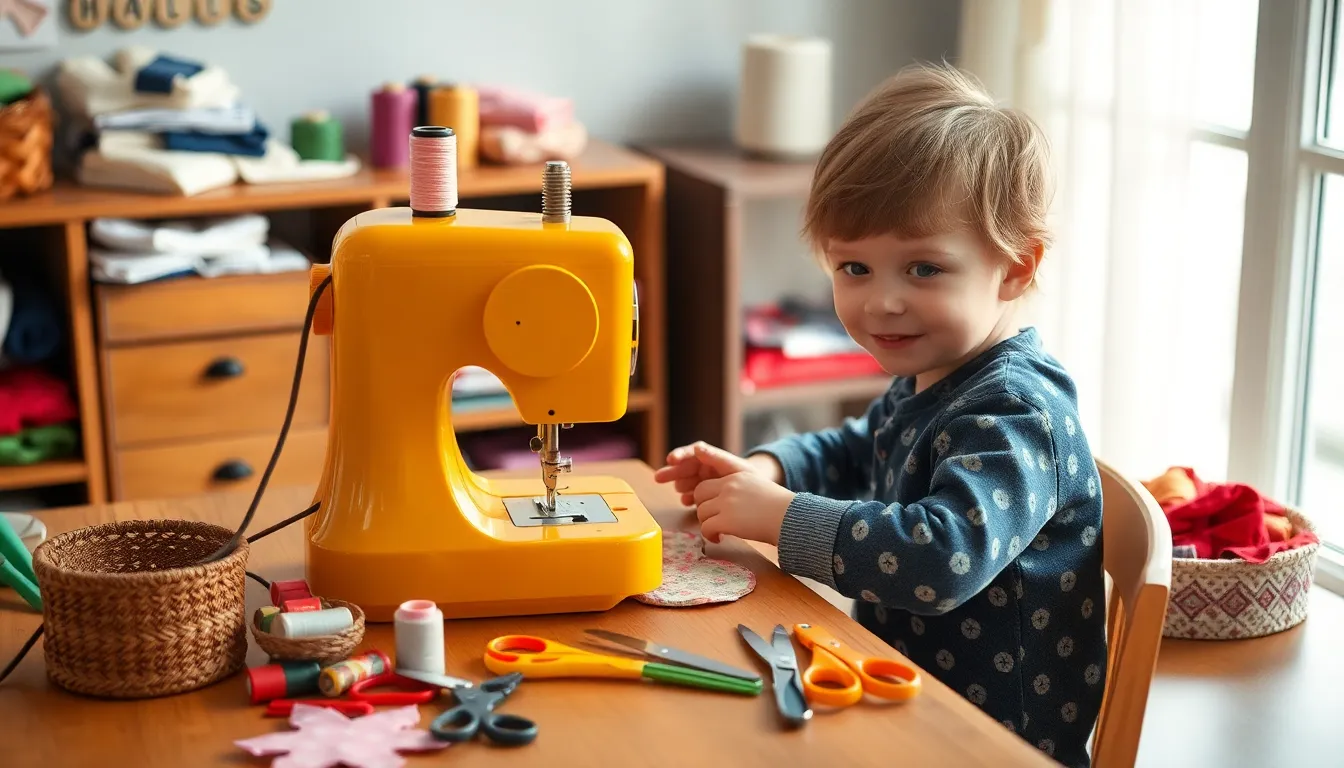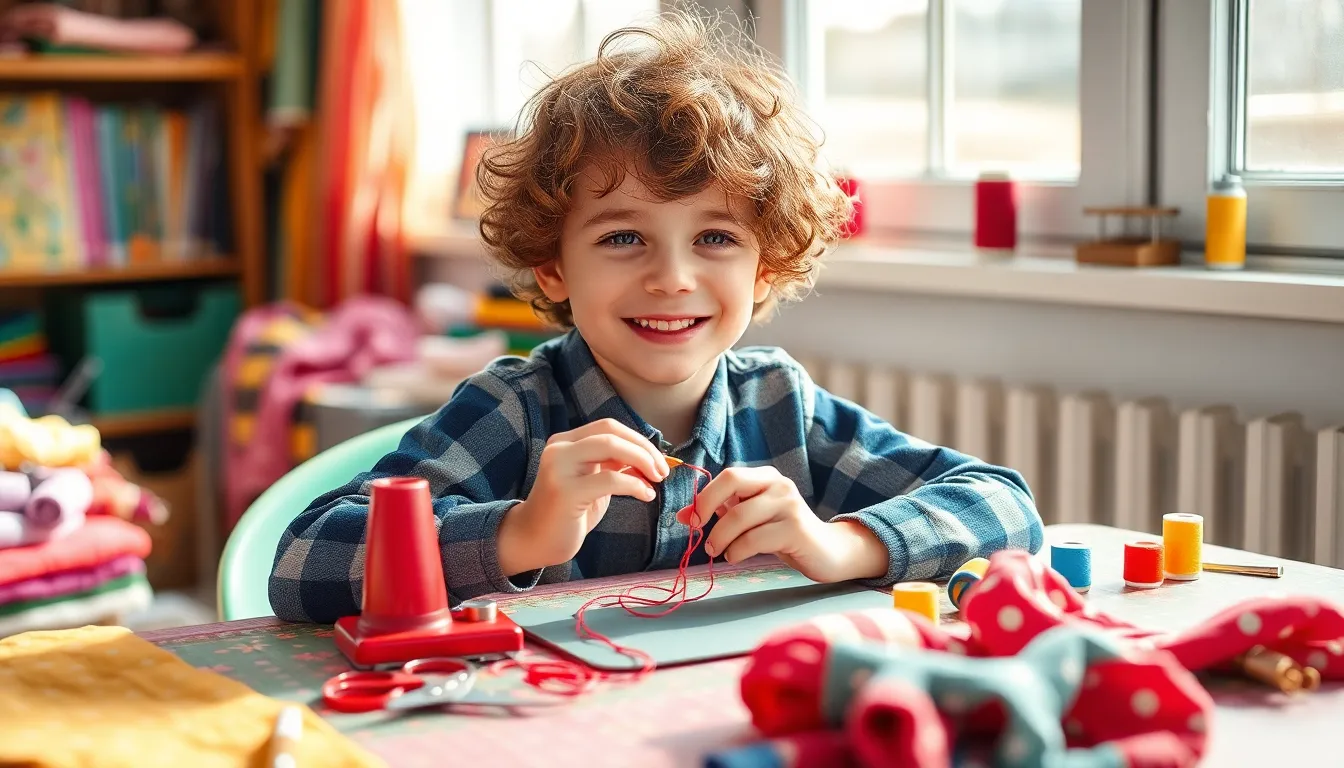Sewing for kids isn’t just a crafty pastime; it’s a ticket to unleashing creativity and building confidence. Imagine tiny hands stitching together their wildest dreams—literally! From patching up their favorite stuffed animals to creating quirky costumes for dress-up days, sewing empowers children to express themselves while having a blast.
Table of Contents
ToggleBenefits of Sewing for Kids
Sewing offers numerous advantages for children. Engaging in this activity enhances various skills while providing an outlet for creativity.
Development of Fine Motor Skills
Children develop fine motor skills through sewing. Threading needles and manipulating fabric require precision and control. When crafting projects, they strengthen hand-eye coordination. Tasks like cutting materials and tying knots promote dexterity. Improved fine motor skills contribute to better performance in other school activities. By focusing on intricate details, kids gain confidence in their capabilities.
Enhancement of Creativity
Sewing enhances creativity in unique ways. It encourages kids to express their individuality through design choices. Selecting colors, patterns, and fabrics fosters imaginative thinking. When children bring their creative visions to life, they experience a sense of ownership. Each project becomes an opportunity for self-expression and exploration. As they experiment with different techniques, kids uncover new methods and ideas, expanding their artistic boundaries.
Essential Tools for Kids

Selecting the right tools enhances the sewing experience for kids. Essential tools help them develop skills while enjoying crafts.
Sewing Machines
Sewing machines designed for beginners offer user-friendly features. Some possess speed control, making them safe for young sewers. Brands like Brother and Janome provide lightweight models suitable for children. Machines with built-in stitches allow kids to explore various options without complexity. User manuals often include guidance, ensuring a smooth learning curve. Safety measures, such as covered needle areas, protect young hands. Machines featuring easy-to-use threading mechanisms simplify the setup process, encouraging kids to start sewing independently.
Hand Sewing Supplies
Hand sewing supplies include items like needles, thread, and scissors. Needles specifically designed for beginners often have larger eyes, making threading easier. Kid-friendly scissors with blunt tips ensure safety during projects. A variety of thread colors inspires creativity in choosing designs. Fabric options can include cotton and felt, both easy to work with. Measuring tools, like tape measures, teach kids precision skills. Pins help secure fabric during sewing, promoting neat finishes. By gathering these supplies, kids gain the tools necessary for successful hand sewing projects.
Beginner-Friendly Projects
Various projects cater to beginner sewers, providing engaging tasks that build confidence and skills.
Simple Patterns
Simple patterns serve as an excellent starting point for young sewers. Patterns like pillowcases or tote bags require minimal fabric and basic stitching, making them manageable. Straight lines and basic shapes offer opportunities for learning while also allowing creativity. Kids can personalize their creations with fabric choices or embellishments. Each completed project boosts their confidence, encouraging them to tackle more complex patterns in the future.
Fun Themed Crafts
Fun themed crafts appeal to children’s interests and spark imagination. Projects like fabric bookmarks or Halloween costumes let kids explore their creativity while sewing. They can create costumes of their favorite characters or design personalized gifts for friends. By incorporating themes, each project becomes an exciting adventure, enhancing motivation to continue sewing. Engaging in themed crafts encourages kids to think outside the box and experiment with colors and fabrics, enriching their sewing experience.
Tips for Teaching Kids to Sew
Teaching kids to sew requires a well-thought-out approach that fosters creativity and confidence. Utilizing effective strategies helps ensure they enjoy the process while learning valuable skills.
Creating a Safe Learning Environment
Establishing a safe workspace is crucial for young sewers. Clear any nearby hazards or distractions. Ensure that tools such as scissors and needles are age-appropriate and easily accessible. Setting up a designated area for sewing projects keeps everything organized. During lessons, supervising kids closely allows for immediate assistance and guidance if needed. Encouraging proper use of tools promotes safety and builds good habits early on. Providing comfortable seating and adequate lighting further enhances the learning experience. Keeping the atmosphere positive helps children feel secure as they explore their creativity.
Encouraging Independence and Confidence
Fostering independence encourages kids to take ownership of their projects. Allow them to choose their fabrics and patterns, as this promotes creativity. Sharing age-appropriate tasks helps them tackle challenges successfully. When kids complete projects independently, they gain a sense of accomplishment. Celebrating their successes reinforces their confidence and motivates them to tackle more complex tasks. Providing constructive feedback encourages growth while ensuring they feel supported. Giving them the space to experiment allows for personal discovery and sparks their interest in sewing. Small challenges keep their enthusiasm high and boost their sewing skills effectively.
Resources for Parents and Kids
Sewing resources for kids and their parents offer valuable guidance for enhancing the crafting experience. Parents can explore various avenues to nurture their children’s sewing skills and creativity.
Online Tutorials and Classes
Numerous online platforms provide free or affordable tutorials tailored for young sewers. Websites like YouTube feature channels dedicated to beginner sewing techniques. Kids can learn the basics through step-by-step videos, showcasing everything from threading needles to completing simple projects. Additionally, interactive online classes, offered by companies like Creativebug and Sew Sweet, enable kids to engage directly with instructors. Such resources cater to diverse learning styles, ensuring children receive the support they need.
Books and Magazines
A wide selection of sewing books and magazines exists for children interested in honing their skills. Titles like “Sewing School” and “The Big Book of Sewing for Kids” present engaging projects designed specifically for younger audiences. These publications offer easy-to-follow instructions and colorful illustrations that inspire creativity. Furthermore, magazines such as “Crafts for Kids” frequently showcase sewing projects, guiding children through new techniques. Enhanced literacy and sewing skills emerge from encouraging regular reading about sewing, making this an excellent resource for budding crafters.
Sewing for kids opens a world of creativity and skill development that can last a lifetime. By engaging in this hands-on activity, children not only express themselves but also gain valuable motor skills and confidence. The right tools and beginner-friendly projects can make the learning process enjoyable and rewarding.
Encouraging kids to explore their creativity through sewing fosters independence and problem-solving abilities. With a wealth of resources available, parents can easily support their child’s journey into the world of sewing. Embracing this creative outlet can lead to memorable experiences and a strong foundation for future crafting adventures.


